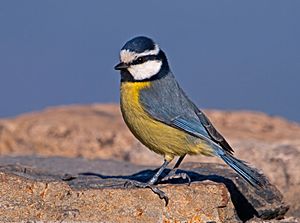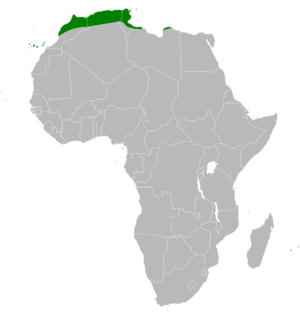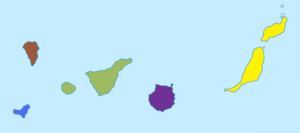African blue tit facts for kids
Quick facts for kids African blue tit |
|
|---|---|
 |
|
| Conservation status | |
| Scientific classification | |
 |
|
| Synonyms | |
|
Parus teneriffae Lesson, 1831 |
The African blue tit (scientific name: Cyanistes teneriffae) is a small, colorful bird. It belongs to the Paridae family, which includes many types of tits. You can find these birds in northern Africa, on an Italian island called Pantelleria, and in the Canary Islands (which belong to Spain).
These birds love to live in temperate forests. For a long time, scientists thought the African blue tit was the same species as the Eurasian blue tit. However, they are now considered different species. The African blue tit is quite common, especially on the islands of Tenerife and Gran Canaria. Because they live on islands, scientists often study them to learn about how animals change over time.
Contents
Where African Blue Tits Live
The African blue tit lives in northern Africa, on the island of Pantelleria in Italy, and across the Canary Islands. They are very common on the islands of Tenerife and Gran Canaria.
However, you might find fewer of them on Fuerteventura and Lanzarote.
What African Blue Tits Look Like
The African blue tit is a small bird, about 11 to 12 centimeters (4 to 5 inches) long. It has a sharp beak and a compact body.
The main type of African blue tit has a white forehead and a white stripe above its eye. Its crown (the top of its head) is a shiny deep blue, which turns almost black on its neck. Its back is blue, and its belly is yellow.
Their song is a mix of one or two notes, repeated in different ways.
What African Blue Tits Eat
African blue tits eat many different kinds of caterpillars. Their diet is very similar to that of their close relative, the Eurasian blue tit.
African Blue Tit Habitat
African blue tits prefer to live in temperate forests. They can be found in both low-lying and high-up forest areas.
On the islands of Fuerteventura and Lanzarote, they prefer forests in lower areas. But on Tenerife and Gran Canaria, they like to live in forests higher up in the mountains.
African Blue Tit Reproduction
African blue tits usually breed from February to July. They might also breed sometimes from October to January. Birds living in lower areas tend to breed earlier in the year than those in mountain areas.
They lay their eggs when the days are longer. They also choose their mates and lay eggs when there are lots of caterpillars available for their babies to eat.
These birds do not move far from where they are born. Young birds stay in the same area even after they learn to fly.
African Blue Tit Subspecies
As mentioned, the African blue tit and the Eurasian blue tit used to be considered the same species. But now we know they are different.
There are several types, or "subspecies," of the African blue tit:
- C. t. palmensis – This one is called the Palma blue tit. It lives on La Palma, in the northwest Canary Islands.
- C. t. ombriosus – This subspecies lives on El Hierro, in the southwest Canary Islands.
- C. t. teneriffae – This is the Canary blue tit. It lives on La Gomera and Tenerife, in the central-west Canary Islands.
- C. t. hedwigii – This type lives on Gran Canaria, in the central Canary Islands.
- C. t. degener – You can find this one on Lanzarote and Fuerteventura, in the eastern Canary Islands.
- C. t. ultramarinus – This is the Ultramarine tit. It lives on Pantelleria (Italy) and in northwest Africa, from Morocco to northern Tunisia.
- C. t. cyrenaicae – This one is known as the Libyan blue tit. It lives in northeast Libya.
The subspecies found in the Canary Islands have a black cap on their heads. The African forms have a blue back. Scientists are still studying these groups. They are trying to see if some of these subspecies should be considered completely separate species.
In 2007, research showed that African blue tits on the eastern Canary Islands (Fuerteventura and Lanzarote) are very similar to those in North Africa. Because of this, the subspecies degener is now often grouped with ultramarinus.
See also
 In Spanish: Herrerillo canario para niños
In Spanish: Herrerillo canario para niños




